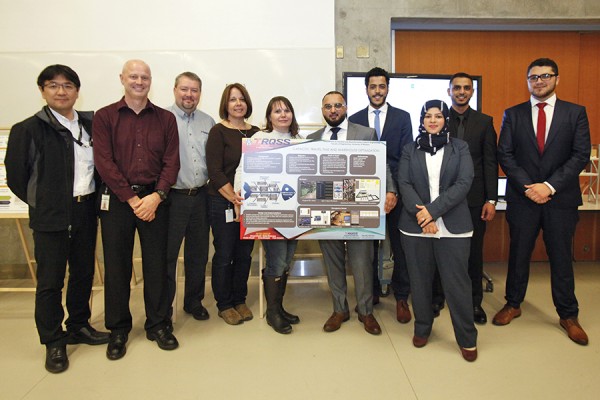 Members of a capstone team pose with TRQSS employees at the industrial engineering capstone presentation day, March 31.
Members of a capstone team pose with TRQSS employees at the industrial engineering capstone presentation day, March 31.
A local seatbelt manufacturer will save nearly $10,000 a year thanks to a warehouse optimization strategy produced by industrial engineering students at the University of Windsor.
Ahmed Khalid, one of several students who worked with TRQSS as part of a capstone project, said his team proposed using ultrasonic sensors to help the Windsor auto supplier track products in its warehouse.
“The ultrasonic sensor sends data to a cloud using Wi-Fi, which then sends a notification to a phone and updates the occupancy of the slot in the google drive,” Khalid said during an industrial engineering capstone presentation day, March 31 in the Centre for Engineering Inovation. “Having sensors in every slot in the warehouse will let us know which are empty and which are occupied, therefore reducing the search time of the forklift operating.”
TRQSS, which supplies seatbelts to Toyota, Subaru and Lexus, plans on implementing the sensors and new software developed by UWindsor students by the end of the year.
Professor Jill Urbanic said industrially supported capstone projects expose students in their final year of undergraduate study to real life challenges. Nearly 40 students presented research related to warehousing; logistics; and product and process solutions for waste minimization.
“We have an excellent set of industrial partners this year and our students have really grown because of their work with them,” Dr. Urbanic said.
Nine student teams — some of which included students from the Odette School of Business — partnered with TRQSS, Erie Architectural Products, Dieffenbacher, A.P. Plasman, Ford, the Electromac Group and Karima Bawa, a senior fellow for the Centre for International Governance Innovation.
“We don’t always get to see what’s out there — what’s new and innovative,” said Kim Talbot, a production coordinator at TRQSS. “It’s nice to get the students’ fresh eyes. We really like the sensor idea. With us getting new programs and new products, we need to save time elsewhere in order to handle the extra workload without adding manpower.”
Khalid said his team visited TRQSS roughly 15 times and spent several days following the forklift around and asking questions to learn more about plant operations and its 800 associates.
“We reduced 41 minutes from the forklift’s travel time and $12 per shift, which saves approximately $9,000 per year,” Khalid said. “The total cost of the project is $10,900. In 14 months, we can recover all of the costs and then it’s just savings.”
Urbanic said at least half of the student projects provide a different way of looking at a problem that industry may have never thought of before: “Students have fresh eyes, are unbiased and can give them something to think about, and to me, that’s a job well done.”
